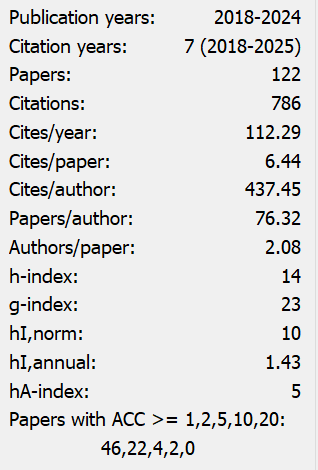Jobs not Threatened by Automation in the Future in the Slovak Republic
Abstract
Industry 4.0 brings with it an increase in new forms and methods of work based on automation and digitization, which gradually threaten jobs in individual countries. Most studies published on this topic describe the expected proportion of jobs that are threatened with extinction. The aim of the presented study is to investigate the opportunities that the introduction of Industry 4.0 brings with it.
The presented study calculates the share of jobs with a low risk of being threatened by automation in the Slovak Republic. This is a unique approach to researching the impact of innovation trends on the labor market, which identifies jobs that are difficult to replace by machines. The calculation of the share of jobs with a low risk of being threatened by automation is based on the connection of two data sources – National system of occupations (a description of the skills required for every job in the Slovak Republic) and Information system on the price of work (modern and effective national labour cost statistical survey focus on wage earnings, including the calculation of the number of employees in individual job positions).
Of the total number of 2 million working people in the Slovak Republic, 24% will not be threatened by automation. These are jobs that require at least one of the following skills for their performance: creativity, organizing and planning work, the ability to make decisions and take responsibility, leadership skills, critical thinking and talent. Several authors investigating the issue of innovations and their effects on jobs define the above-mentioned skills as difficult to be replaced by machines.
The findings presented in the paper create space for further discussion at the national level about which skills and competences will need to be supported in lifelong learning among employees in order to prevent the high rate of replacement of jobs by automation, which the OECD predicts for the Slovak Republic.
References
Acemoglu, D., & Autor, D. (2011). Skills, Tasks and Technologies: Implications for Employment and Earnings. In Handbook of Labor Economics (pp. 1043-1171, Volume 4). Elsevier. https://doi.org/10.1016/S0169-7218(11)02410-5
Arntz, M., Terry, G., & Ulrich, Z. (2016). The risk of automation for jobs in OECD countries. In OECD Social, Employment and Migration Working Papers: OECDiLibrary [online], 189(34s). [cit. 2022-01-19]. ISSN: 1815-199X. Retrieved from https://www.oecd-ilibrary.org/social-issues-migration-health/the-risk-of-automation-for-jobs-in-oecd-countries_5jlz9h56dvq7-en
Autor, H. David. (2015). Why are there still so many jobs? The history and future of Workplace automation. Journal of Economic Perspectives, 29(3), 3-30. https://doi.org/10.1257/jep.29.3.3
Badet, J. (2021). AI, Automation and New Jobs. Open Journal of Business and Management, 9, 2452-2463. https://doi.org/10.4236/ojbm.2021.95132. AI, Automation and New Jobs (scirp.org) https://doi.org/10.4236/ojbm.2021.95132
Benhamou, S., & Janin, L. (2018). Intélligence artificielle et travail. Paris: France Stratégie. Retrieved from https://www.strategie.gouv.fr/sites/strategie.gouv.fr/files/atoms/files/fs-rapport-intelligence-artificielle-28-mars-2018.pdf
Benzel, S., Kotlikoff, L., LaGarda, G. et al. (2015). Robots Are Us: Some Economics of Human Replacement. NBER Working Paper. https://doi.org/10.3386/w20941
Bonin, H., Gregory, T., & Zierahn, U. (2015). Übertragung der Studie von Frey/Osborne auf Deutschland. Endbericht Kurzexpertise, 57.
Bowles, J. (2015). The Computerisation of European Jobs. Who Will Win and Who Will Lose from the Impact of New Technology onto Old Areas of Employment? Bruegel (2014). Accessed 6th Oct 2015. Retrieved from http://www.bruegel.org/nc/blog/detail/article/1394-the-computerisation-of-european-jobs/
Carl Benedikt Frey, & Michael A. Osborne. (2017). The future of employment: How susceptible are jobs to computerisation? Technological Forecasting and Social Change, 114, 254-280. ISSN 0040-1625, https://doi.org/10.1016/j.techfore.2016.08.019
CEDEFOP. (European Centre for the Development of Vocational Training) (n.d.). Automation of Work and Skills. https://www.cedefop.europa.eu/en/events-and-projects/projects/digitalisation-and-future-work/automation-work-and-skills
Dahlin, Eric (2019). Are Robots Stealing Our Jobs? Sociological Research for a Dynamic World, 5, 1-14. https://doi.org/10.1177/2378023119846249
David H. Autor, Frank Levy, & Richard J. Murnane (2003). The Skill Content of Recent Technological Change: An Empirical Exploration. The Quarterly Journal of Economics, 118(4), 1279-1333. https://doi.org/10.1162/003355303322552801
Deloitte. Expected skills needs for the future of work: Understanding the expectations of the European workforce [online]. 2018. [cit. 2022-01-19]. Retrieved from https://www2.deloitte.com/be/en/pages/public-sector/articles/upskilling-the-workforce-in-european-union-for-the-future-of-work.html
Ernst, E., Merola, R., & Samaan, D. (2019). Economics of artificial intelligence: Implications for the future of work. IZA Journal of Labor Policy, 9(1), 1-35. ISSN 2193-9004, Sciendo, Warsaw. https://doi.org/10.2478/izajolp-2019-0004
Európska komisia. Správa o Slovensku 2019 (COM (2019)150 final). [electronic source]. EUR-Lex, 2019a, online. 75 s. [cit. 2022-01-03]. Retrieved from https://ec.europa.eu/info/sites/default/files/file_import/2019-european-semester-country-report-slovakia_sk.pdf
FREY, Carl Benedikt & OSBORNE, Michael A. (2013). The Future of Employment: How Susceptible are Jobs to Computerisation? [elektronický zdroj]. 72s. [cit. 2021-12-29]. Retrieved from https://www.oxfordmartin.ox.ac.uk/downloads/academic/The_Future_of_Employment.pdf
Graetz, G., & Michaels, G. (2015). Robots at Work. Discussion Paper No. 1335, CEP. https://doi.org/10.2139/ssrn.2589780
Guo, K. M. (2019). Artificial Intelligence Development, Industrial Structure Transformation and Upgrading and Changes in Labor Income Share. Management World, 35, 60-77+202-203.
Han, Y. (2022). The Impact of Industrial Robots on the Skill-Based Wage Gap. American Journal of Industrial and Business Management, 12, 571-602. https://doi.org/10.4236/ajibm.2022.124031
Hirsch-Kreinsen, H. (2016). Digitalisation and low-skilled work. Wiso Diskurs, 19, 2016. Retrieved from https://uk.fes.de/fileadmin/user_upload/publications/files/12864.pdf
Janku, Šárka & Petříková, Ružena (2015). The using of innovation and creativity is inexhaustible. Procedia Economics and Finance, 34, 638-643. Elsevier. https://doi.org/10.1016/S2212-5671(15)01679-2
Kamasak, Rifat (2015). Determinants of innovation performance: a resource-based study. Procedia - Social and Behavioral Sciences, 195, 1330-1337. Elsevier. https://doi.org/10.1016/j.sbspro.2015.06.311
Kuzminov, Y., Sorokin, P., & Froumin, I. (2019). Generic and Specific Skills as Components of Human Capital: New Challenges for Education Theory and Practice. Foresight and STI Governance, 13(2), 19-41. https://doi.org/10.17323/2500-2597.2019.2.19.41
Law no. 5/2004 Coll. on employment services and on amendments to certain laws.
Manyika, J., & Sneader, K. (2018, June 1). AI, Automation, and the Future of Work: Ten Things to Solve for. McKinsey Global Institute. Retrieved from https://www.mckinsey.com/featured-insights/future-of-work/ai-automation-and-the-future-of-work-ten-things-to-solve-for#
Nedelkoska, L., & Quintini, G. (2021). Automation, skills use and training (electronic source). OECD, 14.3.2018, online. 125s. [cit. 2021-12-09]. ISSN: 1815199X. Retrieved from https://www.oecd-ilibrary.org/employment/automation-skills-use-and-training_2e2f4eea-en;jsessionid=ESOuum3UYcht16MwHQWNkH2I.ip-10-240-5-165
NSP. Sektorovo riadené inovácie (electronic source). [cit. 2022-04-05]. Retrieved from https://www.sustavapovolani.sk/o_portali
Rad, Fakheddin, F., et al. (2022). Industry 4.0 and supply chain performance: A systematic literature review of the benefits, challenges, and critical success factors of 11 core technologies. Industrial Marketing Management, 105, 268-293. Elsevier. Retrieved from https://reader.elsevier.com/reader/sd/pii/S001985012200147X?token=C67B9B874505EACCAB49A37A9664A05CA012C4712A0CC1C95BFBAF124F1F933CCB191EB60AB73DF53FD44129E111E5ED&originRegion=eu-west-1&originCreation=20220726141221
Rampersad, Giselle (2020). Robot will take your job: Innovation for an era of artificial intelligence. Journal of Business Research, 116, 68-74. Elsevier. Retrieved from https://www.sciencedirect.com/science/article/pii/S0148296320303118
Sachs, D. J., & Kotlikoff, J. L. (2012). Smart Machines and Long-Term Misery. NBER Working Paper No. 18629. https://doi.org/10.3386/w18629
Schlogl Lukas, Elias Weiss, Barbara Prainsack. (2021). Constructing the ‘Future of Work’: an analysis of the policy discourse New Technol. Work. Employ, 36(3), 307-326. https://doi.org/10.1111/ntwe.12202
Smith, Noah (2018). As Long as There Are Humans, There Will Be Jobs. Retrieved April 4, 2018. Retrieved from https://www.bloomberg.com/opinion/articles/2018-03-23/robots-won-t-take-all-jobs-because-humans-demand-new-things.
Štátny Inšitút Odborného Vzdelávania. Stratégia celoživotného vzdelávania a poradenstva na roky 2021 – 2030. [elektronický zdroj]. 2021, online. 63 s. [cit. 2022-04-06]. Retrieved from https://siov.sk/wp-content/uploads/2021/09/na-webNavrh-Strategie-celozivotneho-vzdelavania-a-poradenstva-2021-2030-na-webkorjv_ciste.pdf
Trexima Bratislava. Metodické Pokyny pre štatistické zisťovania o cene práce ISCP (MPSVR SR) 1-04. [elektronický zdroj]. 2017, online. 20 s. [cit. 2021-11-08]. Retrieved from https://www.trexima.sk/wp-content/uploads/2017/07/ISCP-metodicky_pokyn.pdf
Trexima Bratislava. Sektorovo riadenými inováciami k efektívnemu trhu práce v Slovenskej republike: Úvodná správa [elektronický zdroj]. 2019b, online. 342 s. [cit. 2022-01-06]. Retrieved from https://www.employment.gov.sk/files/slovensky/praca-zamestnanost/podpora-zamestnanosti/sri/uvodna-sprava-final-21.5.2019.pdf
Turja, T., Särkikoski, T., Koistinen, P., & Melin, H. (2022). Basic human needs and robotization: How to make deployment of robots worthwhile for everyone? Technology in Society, 68, 101917. https://doi.org/10.1016/j.techsoc.2022.101917
Decree No. 449/2020 Coll. Statistical Office of the Slovak Republic, which issues the statistical classification of employment.
Act No. 5/2004 Coll. on employment services and on amendments to certain laws.
Wilson, James H., & Daugherty, Paul L. (2018). Collaborative Intelligence: Humans and AI are Joining Forces. Harvard Business Review, 96(4), 114-123.
Orld Economic Forum. (2020). The Future of Jobs Report 2020 [elektronický zdroj]. 2020, online. 163 s. [cit. 2022-01-10]. Retrieved from https://www3.weforum.org/docs/WEF_Future_of_Jobs_2020.pdf
Zinser, M., Sirkin, H., & Rose, J. R. (2015, September 23). The Robotics Revolution: The Next Great Leap in Manufacturing. Boston Consulting Group. Retrieved from https://www.bcg.com/publications/2015/lean-manufacturing-innovation-robotics-revolution-next-great-leap-manufacturing


This work is licensed under a Creative Commons Attribution 4.0 International License.
Copyright for this article is retained by the author(s), with first publication rights granted to the journal.
This is an open-access article distributed under the terms and conditions of the Creative Commons Attribution license (http://creativecommons.org/licenses/by/4.0/).


























